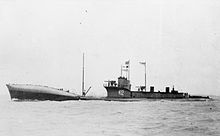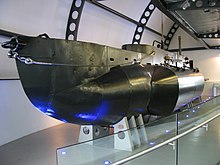Lista okrętów podwodnych Royal Navy
Wygląd
To jest lista okrętów podwodnych Zjednoczonego Królestwa, podana chronologicznie według typów. Daty oznaczają okres budowy danego typu.
Benzynowo-elektryczne
[edytuj | edytuj kod]
- typ Holland – 5 okrętów, 1901–1902[1]
- typ A – 13 okrętów, 1902–1905[1]
- typ B – 11 okrętów, 1904–1906[2]
- typ C – 38 okrętów, 1906–1910[2]
Diesel-elektryczne
[edytuj | edytuj kod]


- typ D – 8 okrętów, 1908–1912[2]
- typ E – 58 okrętów, 1912–1916[3]
- E1 • E2 • E3 • E4 • E5 • E6 • E7 • E8 • E9 • E10 • E11 • E12 • E13 • E14 • E15 • E16 • E17 • E18 • E19 • E20 • E21 • E22 • E23 • E24 • E25 • E26 • E27 • E29 • E30 • E31 • E32 • E33 • E34 • E35 • E36 • E37 • E38 • E39 • E40 • E41 • E42 • E43 • E44 • E45 • E46 • E47 • E48 • E49 • E50 • E51 • E52 • E53 • E54 • E55 • E56
- typ F – 3 okręty, 1913–1917[4]
- typ S – 3 okręty, 1914–1915[5]
- typ V – 4 okręty, 1914–1915[4]
- typ W – 4 okręty, 1914–1915[4]
- typ G – 14 okrętów, 1915–1917[6]
- typ H – 44 okręty, 1915–1919[7]
- typ J – 7 okrętów, 1915–1917[8]
- typ M – 4 okręty, 1917–1918[7]
- „Nautilus” – 1 okręt, 1917[6]
- typ L – 34 okręty, 1917–1919[9]
- typ R – 12 okrętów, 1918[10]
- X1 – 1 okręt, 1921[11]
- typ Odin – 9 okrętów (podtypy Oberon 1, Oxley 2, Odin 6), 1926–1929[12]
- typ Parthian – 6 okrętów, 1929[13]
- „Pandora” • „Parthian” • „Perseus” • „Phoenix” • „Poseidon” • „Proteus”
- typ Rainbow – 4 okręty, 1930[13]
- typ S – 62 okręty (podtypy Swordfish 4, Shark 8, Seraph 33, Subtle 17), 1931–1945[14]
- „Seahorse” • „Starfish” • „Sturgeon” • „Swordfish” • „Salmon” • „Sealion” • „Seawolf” • „Shark” • „Snapper” • „Spearfish” • „Sterlet” • „Sunfish” • P222 • „Safari” • „Saga” • „Sahib” • „Sanguine” • „Saracen” • „Satyr” • „Sceptre” • „Scorcher” • „Scotsman” • „Scythian” • „Sea Devil” • „Seadog” • „Sea Nymph” • „Sea Rover” • „Sea Scout” • „Selene” • „Seneschal” • „Sentinel” • „Seraph” • „Shakespeare” • „Shalimar” • „Sibyl” • „Sickle” • „Sidon” • „Simoom” • „Sirdar” • „Sleuth” • „Solent” • „Spark” • „Spearhead” • „Spirit” • „Spiteful” • „Splendid” • „Sportsman” • „Springer” • „Spur” • „Statesman” • „Stoic” • „Stonehenge” • „Storm” • „Stratagem” • „Strongbow” • „Stubborn” • „Sturdy” • „Stygian” • „Subtle” • „Supreme” • „Surf” • „Syrtis”
- typ Thames – 3 okręty, 1932[15]
- typ Grampus – 5 okrętów, 1935–1938[16]
- „Cachalot” • „Grampus” • „Narwhal” • „Porpoise” • „Rorqual” • „Seal”
- typ T – 52 okręty (podtypy Triton 15, Tempest 15, Taciturn 22), 1937–1945[17]
- „Taku” • „Talisman” • „Tarpon” • „Tetrarch” • „Thetis”/„Thunderbolt” • „Thistle” • „Tigris” • „Torbay” • „Triad” • „Tribune” • „Trident” • „Triton” • „Triumph” • „Truant” • „Tuna” • „Tempest” • „Thorn” • „Thrasher” • „Traveller” • „Trooper” • „Trusty” • „Turbulent” • P311 • „Tabard” • „Taciturn” • „Tactician” • „Talent” (P322) • „Talent” (P337) • „Tally-Ho” • „Tantalus” • „Tantivy” • „Tapir” • „Tarn” • „Taurus” • „Telemachus” • „Templar” • „Teredo” • „Terrapin” • „Thermopylae” • „Thorough” • „Thule” • „Tiptoe” • „Tireless” • „Token” • „Totem” • „Tradewind” • „Trenchant” • „Trespasser” • „Truculent” • „Trump” • „Truncheon” • „Tudor” • „Turpin” • „Thor” • „Tiara” • „Theban” • „Threat” • „Talent” (P343)
- typ U – 49 okrętów, 1937–1943[18]
- „Undine” • „Unity” • „Ursula” • „Umpire” • „Una” • „Unbeaten” • „Undaunted” • „Union” • „Unique” • „Upholder” • „Upright” • „Urchin” • „Urge” • „Usk” • „Utmost” • „Uproar” • P32 • P33 • „Ultimatum” • „Umbra” • P36 • „Unbending” • P38 • P39 • P41 • „Unbroken” • „Unison” • „United” • „Unrivalled” • „Unruffled” • P47 • P48 • „Unruly” • „Unseen” • P52 • „Ultor” • „Unshaken” • „Unsparing” • „Usurper” • „Universal” • „Untamed” • „Untiring” • „Varangian” • „Uther” • „Unswerving” • „Vandal” • „Upstart” • „Varne” • „Vox”
- typ P611 – 4 okręty, 1940[19]
- typ V – 22 okręty, 1943–1944[20]
- „Venturer” • „Viking” • „Veldt” • „Vampire” • „Vox” • „Vigorous” • „Virtue” • „Visigoth” • „Vivid” • „Voracious” • „Vulpine” • „Varne” • „Upshot” • „Urtica” • „Vineyard” • „Variance” • „Vengeful” • „Vortex” • „Virulent” • „Volatile” • „Vagabond” • „Votary”
- typ Amphion – 16 okrętów, 1945–1947[21]
- typ Explorer – 2 okręty, 1954–1955[22]
- typ Porpoise – 8 okrętów, 1956–1959[23]
- „Cachalot” • „Finwhale” • „Grampus” • „Narwhal” • „Porpoise” • „Rorqual” • „Sealion” • „Walrus”
- typ Oberon – 13 okrętów, 1959–1966[24]
- typ Upholder – 4 okręty, 1990–1994[25]
- „Unicorn” • „Unseen” • „Upholder” • „Ursula”
Parowo-elektryczne
[edytuj | edytuj kod]
Miniaturowe okręty
[edytuj | edytuj kod]
- typ Welman – ponad 100 jednostek[27]
- typ X – 20 okrętów, 1942–1943[28]
- typ XE – 12 okrętów, 1944[28]
- typ Stickleback – 4 okręty, 1954–1955[22]
Okręty o napędzie nuklearnym
[edytuj | edytuj kod]Okręty Floty
[edytuj | edytuj kod]

- „Dreadnought” – 1 okręt, 1960[23]
- typ Valiant – 2 okręty, 1963–1965[24]
- typ Churchill – 3 okręty, 1968–1970[24]
- typ Swiftsure – 6 okrętów, 1971–1979[29]
- „Swiftsure” • „Sovereign” • „Superb” • „Sceptre” • „Spartan” • „Splendid”
- typ Trafalgar – 7 okrętów, 1981–1991[25]
- „Trafalgar” • „Turbulent” • „Tireless” • „Torbay” • „Trenchant” • „Talent” • „Triumph”
- typ Astute – 7 okrętów (plan), 2010 – obecnie[30]
Okręty z pociskami balistycznymi
[edytuj | edytuj kod]- typ Resolution – 4 okręty, 1964–1969[29]
- typ Vanguard – 4 okręty, 1986–1999[31]
Zobacz też
[edytuj | edytuj kod]Przypisy
[edytuj | edytuj kod]- ↑ a b Gardiner i Gray 1985 ↓, s. 86.
- ↑ a b c Gardiner i Gray 1985 ↓, s. 87.
- ↑ Gardiner i Gray 1985 ↓, s. 87–88.
- ↑ a b c Gardiner i Gray 1985 ↓, s. 89.
- ↑ Gardiner i Gray 1985 ↓, s. 88–89.
- ↑ a b c Gardiner i Gray 1985 ↓, s. 90.
- ↑ a b Gardiner i Gray 1985 ↓, s. 92.
- ↑ Gardiner i Gray 1985 ↓, s. 90–91.
- ↑ Gardiner i Gray 1985 ↓, s. 93–94.
- ↑ Gardiner i Gray 1985 ↓, s. 93.
- ↑ Gardiner i Chesneau 1980 ↓, s. 47.
- ↑ Gardiner i Chesneau 1980 ↓, s. 47–48.
- ↑ a b Gardiner i Chesneau 1980 ↓, s. 48.
- ↑ Gardiner i Chesneau 1980 ↓, s. 49–52.
- ↑ Gardiner i Chesneau 1980 ↓, s. 48–49.
- ↑ Gardiner i Chesneau 1980 ↓, s. 49.
- ↑ Gardiner i Chesneau 1980 ↓, s. 50–51.
- ↑ Gardiner i Chesneau 1980 ↓, s. 50–53.
- ↑ Gardiner i Chesneau 1980 ↓, s. 54.
- ↑ Gardiner i Chesneau 1980 ↓, s. 53–54.
- ↑ Gardiner i Chesneau 1980 ↓, s. 54–55.
- ↑ a b Gardiner i Chumbley 1996 ↓, s. 527.
- ↑ a b Gardiner i Chumbley 1996 ↓, s. 529.
- ↑ a b c Gardiner i Chumbley 1996 ↓, s. 530.
- ↑ a b Gardiner i Chumbley 1996 ↓, s. 532.
- ↑ Gardiner i Gray 1985 ↓, s. 91–92.
- ↑ Friedman 2019 ↓, s. 634.
- ↑ a b Gardiner i Chesneau 1980 ↓, s. 55.
- ↑ a b Gardiner i Chumbley 1996 ↓, s. 531.
- ↑ Saunders 2015 ↓, s. 896.
- ↑ Saunders 2015 ↓, s. 892.
Bibliografia
[edytuj | edytuj kod]- Conway’s All the World’s Fighting Ships 1906–1921. Robert Gardiner, Randal Gray (red.). London: Conway Maritime Press, 1985. ISBN 0-85177-245-5. (ang.).
- Conway’s All the World’s Fighting Ships 1922–1946. Robert Gardiner, Roger Chesneau (red.). London: Conway Maritime Press, 1980. ISBN 0-85177-146-7. (ang.).
- Conway’s All the World’s Fighting Ships 1947–1995. Robert Gardiner, Stephen Chumbley (red.). Annapolis: Naval Institute Press, 1996. ISBN 1-55750-132-7. (ang.).
- Norman Friedman: British Submarines in Two World Wars. Barnsley: Seaforth Publishing, 2019. ISBN 978-1-5267-3817-2. OCLC 1101967019. (ang.).
- Jane’s Fighting Ships 2015-2016. Stephen Saunders (red.). Jane’s Information Group Ltd, 2015. ISBN 978-0-7106-3143-5. (ang.).
